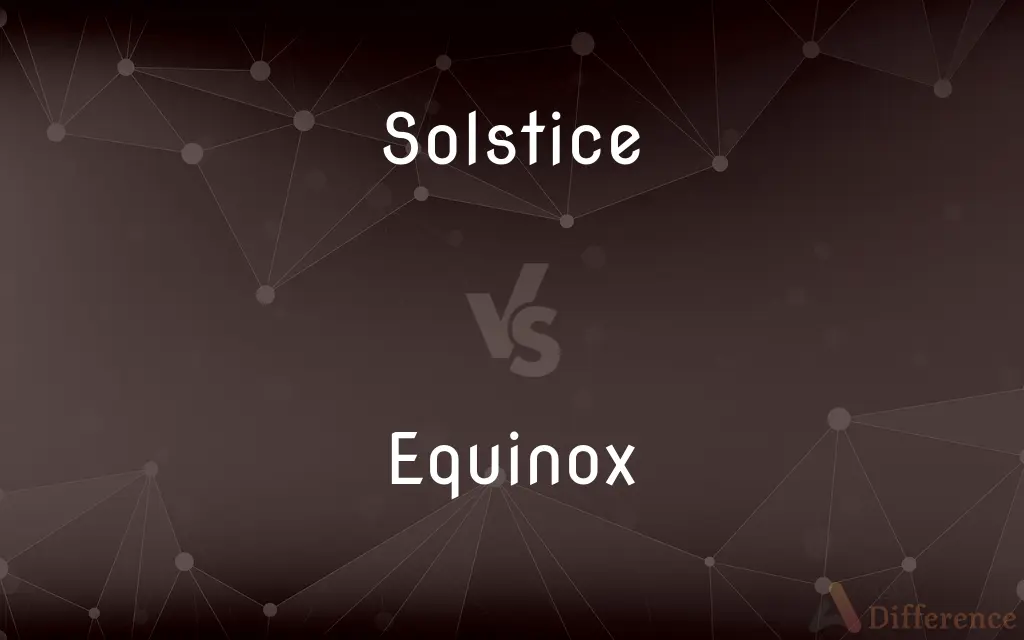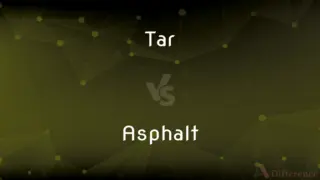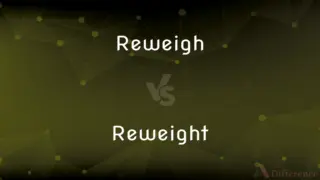Solstice vs. Equinox — What's the Difference?
By Tayyaba Rehman — Updated on October 25, 2023
Solstice is when one hemisphere experiences the longest or shortest day, while an equinox is when day and night are of equal length worldwide.

Difference Between Solstice and Equinox
Table of Contents
ADVERTISEMENT
Key Differences
A solstice is an astronomical event marking the sun's maximum or minimum declination. The equinox, however, is recognized when the sun crosses the celestial equator, resulting in equal lengths of day and night.
The solstice occurs twice a year: once in summer and once in winter. The equinox also happens twice annually, marking the beginning of spring and autumn.
The phenomenon of solstice brings about the longest day in summer and the shortest day in winter for one hemisphere. In contrast, the equinox ensures that all locations on Earth experience roughly 12 hours of daylight and 12 hours of darkness.
Celebrations and traditions related to the solstice often revolve around the peak of summer or the depth of winter. On the other hand, equinox traditions often welcome the changes of spring or fall.
While solstices emphasize the sun's position in relation to the Earth's tilt, equinoxes highlight the sun's position over the equator. Both events are fundamental in understanding the Earth's orbit and the changing of seasons.
ADVERTISEMENT
Comparison Chart
Definition
Marks the longest or shortest day of the year.
Marks equal day and night lengths.
Frequency
Twice a year (summer & winter).
Twice a year (spring & fall).
Daylight
Longest or shortest daylight hours.
Approximately 12 hours of daylight and darkness.
Sun's Position
At its northernmost or southernmost point.
Directly above the equator.
Cultural Significance
Celebrates peak of summer or depth of winter.
Welcomes the onset of spring or fall.
Compare with Definitions
Solstice
The zenith or nadir of the sun's annual journey.
Stonehenge is aligned with the summer solstice sunrise.
Equinox
The time when day and night are of equal duration.
The equinox is a reminder of nature's balance.
Solstice
An event marking the longest or shortest daylight period.
During the summer solstice, the days are incredibly long.
Equinox
A point in the Earth's orbit where hemispheres receive equal sunlight.
Bird migrations often coincide with the equinox.
Solstice
The time when the sun reaches its highest or lowest point.
The winter solstice heralds the start of shorter days.
Equinox
The onset of spring or fall.
The spring equinox is a time of renewal and growth.
Solstice
An astronomical event due to the Earth's tilt.
The solstice helps us understand Earth's axial tilt.
Equinox
An astronomical event marking the sun's position over the equator.
During the equinox, the sun casts no shadow at the equator.
Solstice
A point in Earth's orbit around the sun.
As we approach the solstice, we prepare for seasonal shifts.
Equinox
A celestial occurrence due to Earth's orbit.
Astronomers eagerly observe the equinox to study Earth's rotation.
Solstice
A solstice is an event that occurs when the Sun appears to reach its most northerly or southerly excursion relative to the celestial equator on the celestial sphere. Two solstices occur annually, around June 21 and December 21.
Equinox
An equinox is the instant of time when the plane of Earth's equator passes through the geometric center of the Sun's disk. This occurs twice each year, around 20 March and 23 September.
Solstice
Either of the two times in the year, the summer solstice and the winter solstice, when the sun reaches its highest or lowest point in the sky at noon, marked by the longest and shortest days.
Equinox
The time or date (twice each year) at which the sun crosses the celestial equator, when day and night are of equal length (about 22 September and 20 March).
Solstice
Either of two times of the year when the sun is at its greatest angular distance from the celestial equator. The summer solstice in the Northern Hemisphere occurs about June 21, when the sun is at the zenith on the Tropic of Cancer; the winter solstice occurs about December 21, when the sun is at zenith on the Tropic of Capricorn. The summer solstice is the longest day of the year; the winter solstice is the shortest.
Equinox
Either of two points on the celestial sphere at which the ecliptic intersects the celestial equator.
Solstice
One of the two points in the ecliptic at which the sun is furthest from the celestial equator. This corresponds to one of two days in the year when the day is either longest or shortest.
Equinox
Either of the two times during a year when the sun crosses the celestial equator and when the length of day and night are approximately equal; the vernal equinox or the autumnal equinox.
Solstice
A stopping or standing still of the sun.
Equinox
One of the two occasions in the year when the length of the day and night are equal, which occurs when the apparent path of the Sun (the ecliptic) intersects with the equatorial plane of the Earth; this happens on a day between March 19 and 21 (spring in the Northern Hemisphere, and autumn in the Southern Hemisphere), and on another day between September 21 and 24 (autumn in the Northern Hemisphere, and spring in the Southern Hemisphere); hence, the exact time when the intersection occurs.
Solstice
The point in the ecliptic at which the sun is farthest from the equator, north or south, namely, the first point of the sign Cancer and the first point of the sign Capricorn, the former being the summer solstice, latter the winter solstice, in northern latitudes; - so called because the sun then apparently stands still in its northward or southward motion.
Equinox
The circumstance of a twenty-four hour time period having the day and night of equal length.
Solstice
Either of the two times of the year when the sun is at its greatest distance from the celestial equator
Equinox
(astronomy) One of the two points in space where the apparent path of the Sun intersects with the equatorial plane of the Earth.
Equinox
(obsolete)
Equinox
(rare) A wind]] once thought to occur more frequently around the time of an equinox (sense 1), now known to be a misconception; an equinoctial gale.
Equinox
(astronomy) A plane]] of the Earth's equator (the equatorial plane); also, the Earth's equator.
Equinox
The time when the sun enters one of the equinoctial points, that is, about March 21 and September 22. See Autumnal equinox, Vernal equinox, under Autumnal and Vernal.
When descends on the AtlanticThe giganticStormwind of the equinox.
Equinox
Equinoctial wind or storm.
Equinox
Either of two times of the year when the sun crosses the plane of the earth's equator and day and night are of equal length
Equinox
(astronomy) either of the two celestial points at which the celestial equator intersects the ecliptic
Common Curiosities
What does equinox mean?
An equinox is when day and night are approximately equal in length worldwide because the sun is directly over the equator.
When do equinoxes happen?
Equinoxes occur twice a year, marking the start of spring and autumn.
What is a solstice?
A solstice marks the time when one hemisphere experiences its longest or shortest day due to the Earth's tilt.
Why is the day longest during the summer solstice?
The summer solstice occurs when one hemisphere is tilted most directly towards the sun, resulting in the longest day.
Do solstices impact temperature immediately?
While solstices mark extreme sun positions, temperature changes might lag due to factors like oceanic heat retention.
What cultural celebrations are associated with solstices?
Many cultures have festivals or rituals marking solstices, like midsummer or Yule celebrations.
How often does a solstice occur?
once in summer and once in winter.
What's the significance of equinox in terms of daylight?
During an equinox, all locations on Earth experience roughly 12 hours of daylight and 12 hours of darkness.
How do solstices and equinoxes impact the calendar?
They are pivotal points marking the change of seasons and are often used to align traditional calendars.
Is the equator always in direct sunlight during the equinox?
Yes, during the equinox, the sun is directly above the equator, leading to roughly equal day and night lengths.
Why are equinoxes essential for astronomers?
Equinoxes are crucial for recalibrating observational tools and understanding Earth's orbit dynamics.
Are there traditions related to the equinox?
Yes, traditions like the Easter celebrations or Nowruz often align with the equinoxes.
Are solstices and equinoxes fixed dates?
While they roughly occur around similar dates, slight variations can happen due to the Earth's axial precession.
Can we determine Earth's tilt from observing solstices and equinoxes?
Yes, the extremes of the sun's path during solstices provide insight into Earth's tilt.
How do solstices and equinoxes influence nature and wildlife?
Many natural phenomena, like bird migrations or plant blooming cycles, are influenced by the changing light and temperature conditions brought about by solstices and equinoxes.
Share Your Discovery

Previous Comparison
Tar vs. Asphalt
Next Comparison
Reweigh vs. ReweightAuthor Spotlight
Written by
Tayyaba RehmanTayyaba Rehman is a distinguished writer, currently serving as a primary contributor to askdifference.com. As a researcher in semantics and etymology, Tayyaba's passion for the complexity of languages and their distinctions has found a perfect home on the platform. Tayyaba delves into the intricacies of language, distinguishing between commonly confused words and phrases, thereby providing clarity for readers worldwide.
















































